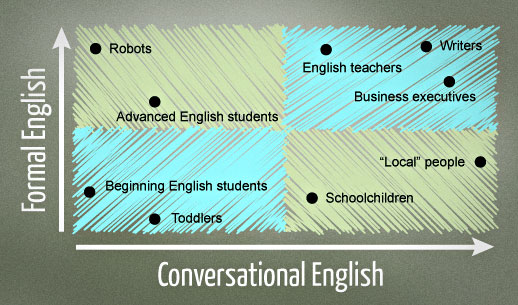English is really two languages
People think of English as being one language, but I think it's more helpful to think of it as two different languages which English speakers switch back and forth between:
- Casual or conversational English. All native English speakers naturally learn this. This is what you'll hear kids using when you walk through the halls of a school. It's how people speak when they're sitting down for lunch at a restaurant. It's in all of the comments on social networking sites like Facebook and Twitter. It's on TV and in movies.
- Formal English. This is the style of English that we use in writing, in academics, in formal speeches, in government, and in business. There are a few households with very strict parents where formal English is spoken and taught from birth. But most people learn it in school. And a lot of native English speakers never gain a very high level of formal English.
Here's where different groups of people fall in their conversational and formal English ability:

- Native English speakers who are highly educated and hold professional jobs can usually use both conversational and formal English well.
- Someone who has a strong "local" identity might speak very fluent conversational English but may not be able to write or speak formally. People like this also often have a strong local accent.
- Robots on TV shows and movies often speak in a very formal English style but aren't able to speak casually. If you don't use casual language well, people may say that you "sound like a robot".
Children learning English as their first language start out learning the casual variety. But people who learn it as a second language are mostly taught formal English in school and in textbooks. There are a few reasons for that:
- Formal English is associated with wealthier and higher-status people, so learners and teachers sometimes look down on more casual language and slang.
- Foreign language teaching has historically grown out of formal native language teaching, so a lot of the content of language books and courses is still based on rules and exercises that were originally made to teach native English speakers the formal version of English.
- A lot of teachers and students just don't realize that there are multiple forms of English. So they often label some language as "incorrect", even if it's used every day by a majority of people in spoken conversations.
The truth is that very few people have considered the idea of teaching or learning casual, conversational English. Not many teachers can describe the "rules" of casual spoken English accurately. Most textbooks don't offer examples of it. The goal of PhraseMix is to help students learn both types of English. But I probably focus more on casual English because there is less good learning material available for it.
Print this Article


